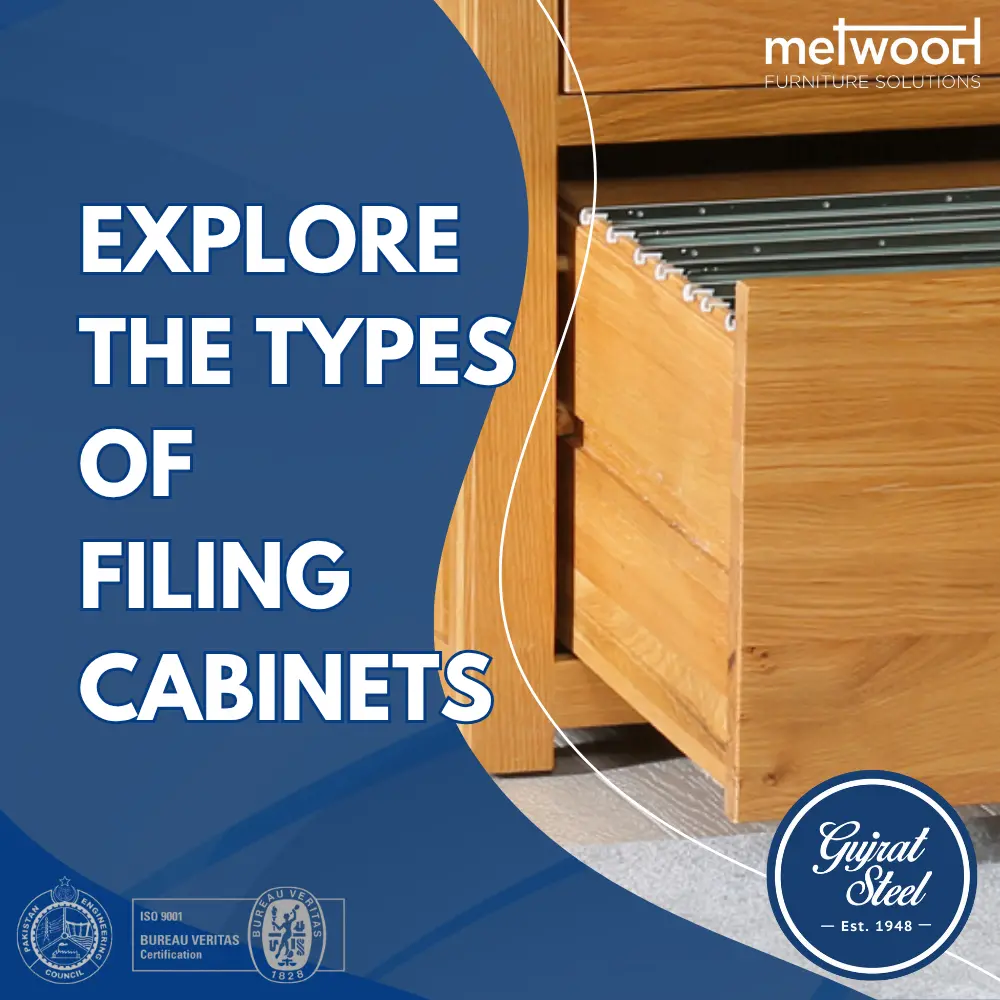Filing cabinets are categorized by design (vertical, lateral) for different space needs, and by special features like fire-resistance or high-security for protecting valuable documents and assets.
Let’s break down the types of filing cabinets into two main groups:
- Types by Design and Orientation: How the cabinet is built and how you access the files.
- Types by Special Features: Cabinets designed for specific protective purposes, like the one you mentioned.
Here is a detailed guide to the different types of filing cabinets.
Table of Contents
Part 1: Types by Design and Orientation
These are the most common types you’ll find in an office environment, differentiated by their shape and how their drawers open.
01. Vertical Filing Cabinets
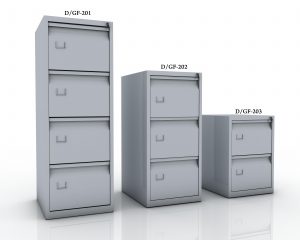
This is the traditional, classic filing cabinet. It’s taller than it is wide and features deep drawers that pull straight out.
Description:
Typically has 2 to 5 drawers stacked on top of each other. Files are arranged from front to back, usually using top-tab folders.
Best For:
Small offices or areas with limited wall space but available height. Low to medium-volume filing.
Pros:
- Small Footprint: Takes up very little floor space.
- Cost-Effective: Generally the most affordable option.
- Widely Available: Easy to find in various materials and colors.
Cons:
- Requires Deep Space: The fully extended drawer requires a lot of clear space in front of the cabinet.
- Limited Visibility: You can only see the top tab of each file, making browsing more difficult.
- Can Tip Over: Taller, heavily loaded cabinets can be a tipping hazard if not properly balanced or anchored.
02. Lateral Filing Cabinets

These cabinets are wider than they are deep, offering a different approach to filing.
Description:
Features wide, shallow drawers. Files can be arranged side-to-side or in multiple rows front-to-back. They usually come in 2 to 4-drawer configurations.
Best For:
High-volume, active filing in busy offices. Areas with limited depth but wide wall space.
Pros:
- High Capacity & Visibility: Holds more files per drawer and allows you to see more files at a glance.
- Space-Saving Depth: The shallow drawers don’t extend as far into the room.
- More Stable: The wide, low profile makes them much more stable and less likely to tip.
- Usable Top Surface: Can be used to hold a printer, office supplies, or other items.
Cons:
- Larger Footprint: Takes up more horizontal floor and wall space.
- More Expensive: Typically cost more than vertical cabinets of similar capacity.
03. Mobile Filing Cabinets (Pedestals)
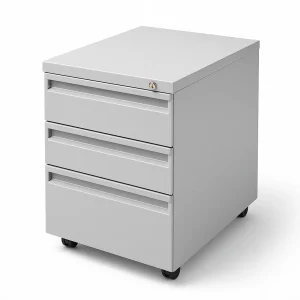
Mobile cabinets are small, compact cabinets designed for flexibility and personal use.
Description:
Small, short cabinets (usually 2 or 3 drawers) set on wheels (casters). They are designed to fit neatly under a desk.
Best For:
Personal workspaces, hot-desking environments, and home offices.
Pros:
- Mobility: Easily moved around as office layouts change.
- Space-Efficient: Fits under a desk, saving valuable floor space.
- Convenience: Keeps active files and personal items within arm’s reach.
Cons:
- Limited Capacity: Only suitable for a small number of files.
- Less Secure: The locks are typically less robust than those on larger cabinets.
04. Open-Shelf Filing Cabinets
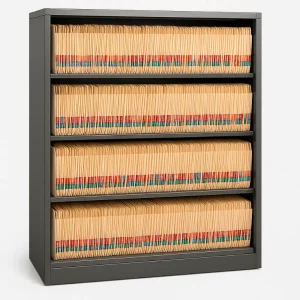
As the name implies, this system does away with drawers entirely.
Description:
A shelving unit, similar to a bookcase, designed for end-tab folders (where the label is on the long side, not the top). Files are accessed directly from the shelf.
Best For:
High-density, frequent-access environments like medical offices, law libraries, and archives.
Pros:
- Fastest Access: No drawers to open and close, making file retrieval much quicker.
- Maximum Density: Stores the most files per square foot of floor space.
- High Visibility: You can see all the file tabs at once.
Cons:
- No Security: Files are exposed and not lockable (unless used in a secure room).
- Exposure to Dust: Files are not protected from dust and environmental factors.
05. Flat File Cabinets
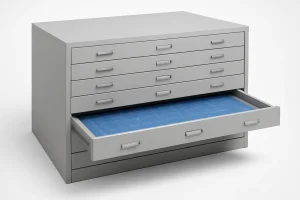
These are highly specialized cabinets designed for oversized documents.
Description:
A stack of very shallow, wide drawers. They are designed for storing documents flat to prevent creases, wrinkles, or damage.
Best For:
Storing blueprints, architectural drawings, maps, artwork, and large photographs.
Pros:
- Protects Oversized Documents: The only proper way to archive large, delicate sheets.
- Archival Quality: Keeps materials flat, organized, and protected.
Cons:
- Very Specialized: Not useful for standard document filing.
- Expensive and Large: They take up a lot of space and are a significant investment.
Part 2: Types by Special Features
This category defines cabinets by what they do, not just how they are shaped. Any of the designs above (especially vertical and lateral) can be built with these features.
06. Fire-Resistant Filing Cabinets
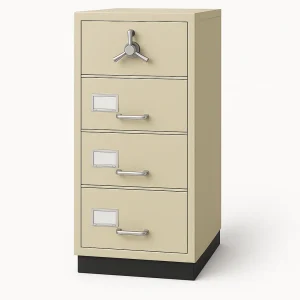
This is a critical category for protecting vital documents from fire. Fire-resistant filing cabinets are essentially ovens in reverse—designed to keep heat out.
Description:
Constructed with a “hollow” wall design filled with a special fire-retardant insulation (often a mix of gypsum and vermiculite). When heated, this insulation releases water vapor, which keeps the internal temperature below the point where paper ignites (around 451°F / 233°C). The drawers have special seals (gaskets) that expand with heat to block flames and hot gases.
Ratings are Key:
Look for a UL (Underwriters Laboratories) rating. A UL Class 350-1 Hour rating means the internal temperature will not exceed 350°F for at least one hour when exposed to a fire of 1700°F. There are also 2-hour and 3-hour ratings.
Best For:
Storing irreplaceable documents: deeds, legal contracts, stock certificates, vital records, and key business papers.
Pros:
- Ultimate Fire Protection: The only proven way to protect paper documents from a fire.
- Impact and Explosion Rated: Many are also rated to survive a fall from several stories or withstand explosions.
Cons:
- Extremely Heavy: The insulation makes them incredibly heavy and difficult to move.
- Very Expensive: They are a significant investment compared to standard cabinets.
- Not for Data: Standard fire-resistant cabinets protect paper, but not digital media (CDs, hard drives, tapes), which are destroyed at much lower temperatures (~125°F). For that, you need a Data/Media Safe.
07. High-Security Filing Cabinets
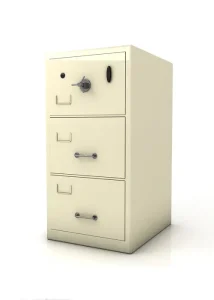
These cabinets are designed to protect against espionage, theft, and unauthorized access, not just fire.
Description:
Built with reinforced, heavy-gauge steel and feature high-security locking mechanisms. These locks are often drill-resistant, tamper-proof, and may require multiple keys or combinations. They are commonly used by government, military, and law enforcement agencies.
Best For:
Storing classified documents, sensitive personnel files, intellectual property, and high-value corporate information.
Pros:
- Superior Intrusion Protection: Extremely difficult to break into.
- Peace of Mind: Ensures sensitive information is secure from theft.
Cons:
- High Cost: Can be even more expensive than fire-resistant models.
- Heavy and Bulky: The reinforced construction adds significant weight.
Summary
When choosing a filing cabinet, you first decide on the design based on your space and access needs (Vertical, Lateral, etc.), and then you decide if you need a special feature like fire or theft resistance based on the value of what you’re storing.



